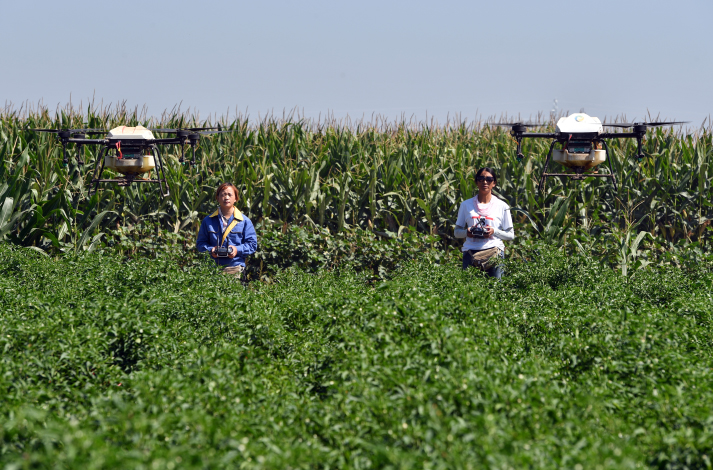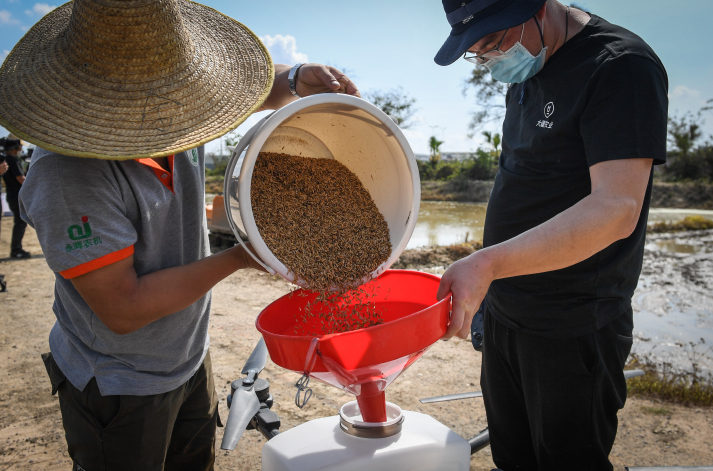| Business |
| Chinese drone companies rise in global competition | |
|
|
 Villagers of Houyoutan in Tangyin County, Henan Province in central China, operate drones on a farmland on September 4 (XINHUA)
After two years of investigation, the U.S. International Trade Commission (ITC) announced at the end of August that it would not enforce a ban on drones of Da Jiang Innovations (DJI), a Chinese unmanned aerial vehicle (UAV) maker, marking a victory for the company in a patent infringement suit. The investigation aimed at preventing intellectual property right infringement of U.S. products and unfair competition in imports. Based in Shenzhen, Guangdong Province in south China, DJI, established in 2006, has become the world's largest drone maker. Since demand for drones is increasing in multiple fields including light shows for entertainment, agriculture, logistics and infrastructure engineering, DJI has expanded its consumer base from individual users to industrial enterprises. Its products have been used for monitoring the fire at the Notre Dame Cathedral last year, spreading seeds, spraying disinfectants during the novel coronavirus disease and inspecting dykes during the flood season, helping improve efficiency and save costs and labor. During 2013-17, its sales revenue almost doubled every year. Its industrial output exceeded 26 billion yuan ($3.8 billion) in 2019. As early as 2017, the U.S. Army announced a ban on DJI drones due to alleged security concerns. Earlier this year, the U.S. Department of the Interior (DOI) grounded its entire fleet of 800 DJI drones for the same reason, although it had validated and approved the DJI government edition in July 2019. After around 15 months of flight tests and technological evaluation since April 2018, a DOI report said there was no indication that data was transmitted outside the high-security system. Despite this, the lack of alternative products has seen DJI maintain its share in the U.S. market. Data released by Drone Industry Insights, a Germany-based commercial drone industrial information provider, earlier this year showed that DJI now accounted for about 77 percent of UAV sales in the U.S. No other competitor occupied more than 4 percent of the market. According to the company, it holds around 70 percent share of the global commercial drone market.  Staff of an agricultural cooperative in Kaiping, Guangdong Province in south China, put rice seeds in a DJI drone on February 26 (XINHUA)
Robust growth As a type of intelligent robot, UAV has an extensive production chain covering technological research and development (R&D), manufacturing of key components, assembly and production, and services for application. Although a late starter in the field, China has seen the UAV industry boom in recent years with the emergence of companies making drones for commercial, industrial and military use. "The R&D, production and on-site trial of UAV require a lot of hard work. Through consistent efforts, many Chinese private enterprises have entered the field and made notable technological breakthroughs," Liang Xu, a former member of the R&D team of the Institute of Unmanned System, Beihang University, said. According to a report on China's civilian drone market from the Shenzhen-based Qianzhan Industry Research Institute, the market was small and developed slowly before 2010, as drones were mainly intended for professional use such as rescue in disasters. After 2012, the UAV industry has developed rapidly with the reduction of costs of major components such as sensors and technological progress. Standing at around 9 billion yuan ($1.3 billion) in 2016, China's drone market expanded steadily in the following years. In 2019, the market reached 23.8 billion yuan ($3.4 billion), a year-on-year increase of 38.4 percent. The sales of civilian drones reached 13.48 billion yuan ($1.9 billion), up 53.2 percent year on year. In May 2017, the Civil Aviation Adminis-tration of China launched a registration system for domestic drone users. Data from the administration showed that the number of registered users reached nearly 371,000 in 2019, up 36.9 percent from the previous year. Among the users, around 320,000 are individuals and 50,000 are enterprises and public institutions, both increasing from 2018. In addition to DJI, more drone makers have emerged in the Chinese market as demands from various fields continue to rise. Beijing TechX Aviation Innovation, a Beijing-based drone startup for military and high-end industrial users, introduced a product named Cygnus in 2018. According to the company, China Earthquake Administration adopted the drone for aerial photography over the Altun Mountains in Xinjiang Uygur Autonomous Region in northwest China last year, collecting information on local geological structure to better predict earthquakes. During the 11-day work, 27 Cygnus drones flew at an altitude of around 5,100 meters on average, taking over 30,000 high-definition photos. As a blue ocean, China's UAV market is still expanding. According to a report released by China-based research firm AskCI Corp., China's industrial UAV market is expected to exceed 50 billion yuan ($7.3 billion) by 2022. A forerunner According to DJI, its rapid development and the firm footing in the global market can be attributed to the innovation-oriented R&D. It has kept introducing new products since 2009. In 2012, the company launched the first quadcopter DJI Phantom 1, making its drones once exclusive to professional users accessible to more consumers. It later released more quadcopters of the Phantom series and gimbal stabilizers in the following years. The Phantom 3 drone introduced in 2015 can transmit high-definition images within 2 km. The flight control systems, gimbal stabilizers and cameras of the drones are all independently developed and produced by the company, where R&D staff represents around 25 percent of the total. As of the end of 2019, it had filed applications for over 11,300 patents. It has also benefited from the strong industrial foundation and government support of Shenzhen, a hub of drone manufacturing in China. Another report on DJI released by the Qianzhan Industry Research Institute showed that the favorable environment and supporting policies for innovation in the UAV industry in the city have strongly backed up the growth of such companies. The local government has established special funding systems to boost emerging UAV enterprises through providing direct assistance and compensation against risks, supporting over 200 drone-related programs every year. Moreover, related industries including carbon fiber raw material for making drones, lithium batteries and training organizations for operating drones have matured in Shenzhen. By the end of 2019, China had 290 qualified UAV training organizations, among which 31 are based in Guangdong and 17 in Shenzhen. The data from Shenzhen UAV Industry Association showed that the city had over 700 drone enterprises last year, with the industrial scale totaling 40 billion yuan ($5.8 billion). While providing preferential policies, it has also introduced rules for regulating the use of drones to ensure public safety. Further development While China has made a giant leap on UAV R&D, there is still a large gap between domestic drones and those from countries with advanced technologies on the manufacturing of chips and engines for UAV devices. Also many countries are investing much more on developing technologies to control drone clusters, Liang said. According to Qianzhan Industry Research Institute, the role of drones in fields including agriculture, logistics, emergency rescue and aerial photography has not yet been brought into full play in China. While drones are used for spraying insecticides on more than half of rice fields in Japan, the proportion stands at just around 6 percent in Heilongjiang Province, a major grain supplier in northeast China. The number of users from enterprises and public institutions also has room for growth. With the development of new intelligent technologies including 5G, artificial intelligence, the Internet of Things, cloud computing and big data, drone manufacturing technologies will be improved, enhancing durability and reducing risks. Costs for making drones and camera carriers will also decline, expanding UAV application. The technological progress, coupled with high domestic demand and supporting policies, will drive China's UAV industry, it said. (Printed Edition Title: Emboldened By Independence) Copyedited by Madhusudan Chaubey Comments to lixiaoyang@bjreview.com |
|
||||||||||||||||||||||||||||
|
